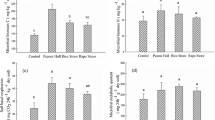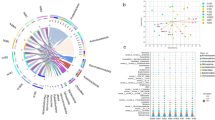Abstract
In this study, biochar was produced from three biomass feedstocks such as fruits of Cassia fistula and Caesalpinia sp. and barks of Eucalyptus globulus. The samples of the obtained biochar were characterized for pH, physiochemical properties, surface morphology, and surface functional groups. The obtained biochar samples were further studied with/without the combination of urea for their plant growth enhancement properties including the germination studies and effect on shoot and root growth of rice plants. Biochar produced from C. fistula fruits at 1.5% concentration increased the plant shoot height 18% higher than the control plants. Eucalyptus sp. barks’ biochar application at 0.5% concentration also increased the plant shoot height 12% longer than the control. However, the biochar produced from Caesalpinia sp. did not increase the shoot length. Yet, a generalized increase in root length was observed with the application of biochar. The combined application of nitrogen fertilizer (urea) and biochar together reverted the effect of biochar on the shoot length increase. Phospholipid-derived fatty acid (PLFA) characterization of soil revealed that soil biota shifts when soil was supplemented with the biochar. The bacterial community increased and a loss of fungal community was observed with the application of biochar.





Similar content being viewed by others
References
Balasubramanian P & Karthickumar P (2017) Biofertilizers and biopesticides: a holistic approach for sustainable agriculture. In: Sustainable utilization of natural resources. pp 255–284. https://doi.org/10.1201/9781315153292
Savci S (2012) An agricultural pollutant: chemical fertilizer. Int J Environ Sci Dev 3(1):73
Matovic D (2011) Biochar as a viable carbon sequestration option: global and Canadian perspective. Energy 36(4):2011–2016
Lehmann J, Gaunt J, Rondon M (2006) Bio-char sequestration in terrestrial ecosystems—a review. Mitig Adapt Strateg Glob Chang 11(2):403–427
Glaser B (2000) Persistence of soil organic matter in archaeological soils (terra preta) of the Brazilian amazon region. pp. 190–194 (No. Reserva Biblioteca/631.417 S964s). En: Sustainable management of soil organic matter. CAB International, Oxon
Zhang J, Lü F, Zhang H, Shao L, Chen D, He P (2015) Multiscale visualization of the structural and characteristic changes of sewage sludge biochar oriented towards potential agronomic and environmental implication. Sci Rep 5:9406
Lee XJ, Lee LY, Gan S, Thangalazhy-Gopakumar S, Ng HK (2017) Biochar potential evaluation of palm oil wastes through slow pyrolysis: thermochemical characterization and pyrolytic kinetic studies. Bioresour Technol 236:155–163
Schulz H, Dunst G, Glaser B (2013) Positive effects of composted biochar on plant growth and soil fertility. Agron Sustain Dev 33(4):817–827
Gerzabek MH, Pichlmayer F, Kirchmann H, Haberhauer G (1997) The response of soil organic matter to manure amendments in a long-term experiment at Ultuna, Sweden. Eur J Soil Sci 48(2):273–282
Kuzyakov Y, Subbotina I, Chen H, Bogomolova I, Xu X (2009) Black carbon decomposition and incorporation into soil microbial biomass estimated by 14C labeling. Soil Biol Biochem 41(2):210–219
Glaser B, Lehmann J, Zech W (2002) Ameliorating physical and chemical properties of highly weathered soils in the tropics with charcoal—a review. Biol Fertil Soils 35(4):219–230
Eykelbosh AJ, Johnson MS, de Queiroz ES, Dalmagro HJ, Couto EG (2014) Biochar from sugarcane filtercake reduces soil CO2 emissions relative to raw residue and improves water retention and nutrient availability in a highly-weathered tropical soil. PLoS One 9(6):e98523
Hansen V, Hauggaard-Nielsen H, Petersen CT, Mikkelsen TN, Muller-Stover D (2016) Effects of gasification biochar on plant-available water capacity and plant growth in two contrasting soil types. Soil Tillage Res 161(1–9):1–9
Egamberdieva D, Wirth S, Behrendt U, Abd_Allah EF, Berg G (2016) Biochar treatment resulted in a combined effect on soybean growth promotion and a shift in plant growth promoting rhizobacteria. Front Microbiol 7:209
Rangabhashiyam S, Balasubramanian P (2019) The potential of lignocellulosic biomass precursors for biochar production: performance, mechanism and wastewater application—a review. Ind Crop Prod 128:405–423
Lehmann J, Rillig MC, Thies J, Masiello CA, Hockaday WC, Crowley D (2011) Biochar effects on soil biota—a review. Soil Biol Biochem 43(9):1812–1836
Downie A, Crosky A, Munroe P (2009) Physical properties of biochar. In: Lehmann J, Joseph S (eds) Biochar for environmental management: science and technology. Earthscan, London, pp 13–32
Czimczik CI, Preston CM, Schmidt MW, Werner RA, Schulze ED (2002) Effects of charring on mass, organic carbon, and stable carbon isotope composition of wood. Org Geochem 33(11):1207–1223
Frostegard A, Tunlid A, Baath E (2011) Use and misuse of PLFA measurements in soils. Soil Biol Biochem 43(8):1621–1625
Buyer JS, Sasser M (2012) High throughput phospholipid fatty acid analysis of soils. Appl Soil Ecol 61:127–130
Swagathnath G, Rangabhashiyam S, Parthsarathi K, Murugan S, Balasubramanian P (2019) Modeling biochar yield and syngas production during the pyrolysis of agro-residues. In: Green buildings and sustainable engineering. Springer, Singapore, pp 325–336
Mohammadi A, Cowie AL, Cacho O, Kristiansen P, Mai TLA, Joseph S (2017) Biochar addition in rice farming systems: economic and energy benefits. Energy 140:415–425
Brewer CE, Unger R, Schmidt-Rohr K, Brown RC (2011) Criteria to select biochars for field studies based on biochar chemical properties. Bioenergy Res 4(4):312–323
Hilioti Z, Michailof CM, Valasiadis D, Iliopoulou EF, Koidou V, Lappas AA (2017) Characterization of castor plant-derived biochars and their effects as soil amendments on seedlings. Biomass Bioenergy 105:96–106
Xin Y, Cao H, Yuan Q, Wang D (2017) Two-step gasification of cattle manure for hydrogen-rich gas production: effect of biochar preparation temperature and gasification temperature. Waste Manag 68:618–625
Li H, Dong X, da Silva EB, de Oliveira LM, Chen Y, Ma LQ (2017) Mechanisms of metal sorption by biochars: biochar characteristics and modifications. Chemosphere 178:466–478
Yuan JH, Xu RK, Zhang H (2011) The forms of alkalis in the biochar produced from crop residues at different temperatures. Bioresour Technol 102(3):3488–3497
Weber K, Quicker P (2018) Properties of biochar. Fuel 217:240–261
Solaiman ZM, Murphy DV, Abbott LK (2012) Biochars influence seed germination and early growth of seedlings. Plant Soil 353(1–2):273–287
Vaughn SF, Dinelli FD, Tisserat B, Joshee N, Vaughan MM, Peterson SC (2015) Creeping bentgrass growth in sand-based root zones with or without biochar. Sci Hortic 197:592–596
Laird D, Fleming P, Wang B, Horton R, Karlen D (2010) Biochar impact on nutrient leaching from a Midwestern agricultural soil. Geoderma 158(3–4):436–442
Rajkovich S, Enders A, Hanley K, Hyland C, Zimmerman AR, Lehmann J (2012) Corn growth and nitrogen nutrition after additions of biochars with varying properties to a temperate soil. Biol Fertil Soils 48(3):271–284
Atkinson CJ, Fitzgerald JD, Hipps NA (2010) Potential mechanisms for achieving agricultural benefits from biochar application to temperate soils: a review. Plant Soil 337(1–2):1–18
Chan KY, Xu Z (2009) Biochar: nutrient properties and their enhancement. Biochar Environ Manag Sci Technol 1:67–84
Prasad M, Tzortzakis N, McDaniel N (2017) Chemical characterization of biochar and assessment of the nutrient dynamics by means of preliminary plant growth tests. J Environ Manag 216:89–95
Agegnehu G, Srivastava AK, Bird MI (2017) The role of biochar and biochar-compost in improving soil quality and crop performance: a review. Appl Soil Ecol 119:156–170
Ding Y, Liu YX, Wu WX, Shi DZ, Yang M, Zhong ZK (2010) Evaluation of biochar effects on nitrogen retention and leaching in multi-layered soil columns. Water Air Soil Pollut 213(1–4):47–55
Graber ER, Elad Y (2013) Biochar impact on plant resistance to disease. Biochar Soil Biota 278
Jin H (2010) Characterization of microbial life colonizing biochar and biochar-amended soils
Taghizadeh-Toosi A, Clough TJ, Sherlock RR, Condron LM (2012) Biochar adsorbed ammonia is bioavailable. Plant Soil 350(1–2):57–69
Asai H, Samson BK, Stephan HM, Songyikhangsuthor K, Homma K, Kiyono Y, Horie T (2009) Biochar amendment techniques for upland rice production in Northern Laos: 1. Soil physical properties, leaf SPAD and grain yield. Field Crop Res 111(1–2):81–84
Chan KY, Van Zwieten L, Meszaros I, Downie A, Joseph S (2008) Agronomic values of greenwaste biochar as a soil amendment. Soil Res 45(8):629–634
Sun H, Lu H, Chu L, Shao H, Shi W (2017) Biochar applied with appropriate rates can reduce N leaching, keep N retention and not increase NH3 volatilization in a coastal saline soil. Sci Total Environ 575:820–825
He T, Liu D, Yuan J, Luo J, Lindsey S, Bolan N, Ding W (2018) Effects of application of inhibitors and biochar to fertilizer on gaseous nitrogen emissions from an intensively managed wheat field. Sci Total Environ 628:121–130
Ameloot N, De Neve S, Jegajeevagan K, Yildiz G, Buchan D, Funkuin YN, Sleutel S (2013) Short-term CO2 and N2O emissions and microbial properties of biochar amended sandy loam soils. Soil Biol Biochem 57:401–410
Lin Y, Ding W, Liu D, He T, Yoo G, Yuan J, Fan J (2017) Wheat straw-derived biochar amendment stimulated N2O emissions from rice paddy soils by regulating the amoA genes of ammonia-oxidizing bacteria. Soil Biol Biochem 113:89–98
Anders E, Watzinger A, Rempt F, Kitzler B, Wimmer B, Zehetner F, Stahr K, Zechmeister-Boltenstern S, Soja G (2013) Biochar affects the structure rather than the total biomass of microbial communities in temperate soils. Agric Food Sci 22(4):404–423
Watzinger A, Feichtmair S, Kitzler B, Zehetner F, Kloss S, Wimmer B et al (2014) Soil microbial communities responded to biochar application in temperate soils and slowly metabolized 13C-labelled biochar as revealed by 13C PLFA analyses: results from a short-term incubation and pot experiment. Eur J Soil Sci 65(1):40–51
Gomez JD, Denef K, Stewart CE, Zheng J, Cotrufo MF (2014) Biochar addition rate influences soil microbial abundance and activity in temperate soils. Eur J Soil Sci 65(1):28–39
Kim JS, Sparovek G, Longo RM, De Melo WJ, Crowley D (2007) Bacterial diversity of terra preta and pristine forest soil from the Western Amazon. Soil Biol Biochem 39(2):684–690
Acknowledgments
Financial support from the Science and Engineering Research Board (SERB), India (File No. ECR/2017/003397) is greatly acknowledged. The authors thank the National Institute of Technology Rourkela for providing the necessary research facilities. The authors acknowledge SAIF, IIT Madras for the use of ICP-OES in measuring CEC property which is presented in the paper. The authors greatly acknowledge the Ministry of Human Resources Development of Government of India for supporting the master’s programme of the first author.
Author information
Authors and Affiliations
Corresponding author
Ethics declarations
Conflict of interest
No potential conflict of interest was reported by the authors.
Additional information
Publisher’s note
Springer Nature remains neutral with regard to jurisdictional claims in published maps and institutional affiliations.
Rights and permissions
About this article
Cite this article
Swagathnath, G., Rangabhashiyam, S., Murugan, S. et al. Influence of biochar application on growth of Oryza sativa and its associated soil microbial ecology. Biomass Conv. Bioref. 9, 341–352 (2019). https://doi.org/10.1007/s13399-018-0365-z
Received:
Revised:
Accepted:
Published:
Issue Date:
DOI: https://doi.org/10.1007/s13399-018-0365-z




